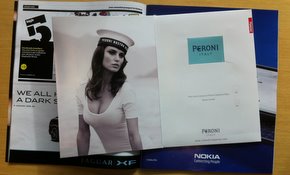
The screens, which show a three-and-a-half minute video, were placed in 2,500 editions of Fairfax’s The (Sydney) Magazine and The (Melbourne) Magazine, which come free with the Sydney Morning Herald and The Age, respectively.
The screens were hand-inserted into the special editions to be distributed by hand to corporate workers in the state capitals by Peroni promo girls. The Melbourne run was distributed last week, with the Sydney run to be handed out this week.
Ravi Wagaarachchi, Fairfax’s media planning and commercial print manager, said the technology proved the versatility of print advertising.
“People are saying that print is dead, but this campaign has shown just how effective it can be when you target certain areas,” he said.
“We have found that this advertisement has had more of a direct impact than commercials on websites.”
Wagaarachchi organised the outsourcing of components for the tiny screens from China, which were built by a team of computer technicians at Fairfax’s Chullora site.
The quarter-of-a-million-dollar campaign embraces Italian style with an advertisement featuring a behind-the-scenes look at Peroni’s glamorous ‘Calendario’ photo shoot.
Fairfax media creative manager Zac Skulander said that the project had been in the works for almost a year.
“We have seen some overseas examples using this technology for standalone direct marketing exercises, but what we really wanted to do was to this into the pages of our magazines,” he said.
280611 fairfax peroni
Fairfax and Peroni create ‘world-first’ TV commercial inserted into print magazine
Fairfax has pushed the parameters of print advertising by inserting a credit card-sized video screen into a magazine as part of a $250,000 marketing campaign for Peroni.
The screens, which show a three-and-a-half minute video, were placed in 2,500 editions of Fairfax’s The (Sydney) Magazine and The (Melbourne) Magazine, which come free with the Sydney Morning Herald and The Age, respectively.
The screens were hand-inserted into the special editions and distributed by hand to corporate workers in the state capitals by Peroni promo girls.
Ravi Wagaarachchi, Fairfax’s media planning and commercial print manager, said the technology proved the versatility of print advertising.
“People are saying that print is dead, but this campaign has shown just how effective it can be when you target certain areas,” he said.
“We have found that this advertisement has had more of a direct impact than commercials on websites.”
Wagaarachchi organised the outsourcing of components for the tiny screens from China, which were built by a team of computer technicians at Fairfax’s Chullora site.
The quarter-of-a-million-dollar campaign embraces Italian style with an advertisement featuring a behind-the-scenes look at Peroni’s glamorous ‘Calendario’ photo shoot.
Fairfax media creative manager Zac Skulander said that the project had been in the works for almost a year.
“We have seen some overseas examples using this technology for standalone direct marketing exercises, but what we really wanted to do was to this into the pages of our magazines,” he said.
Comment below to have your say on this story.
If you have a news story or tip-off, get in touch at editorial@sprinter.com.au.
Sign up to the Sprinter newsletter
